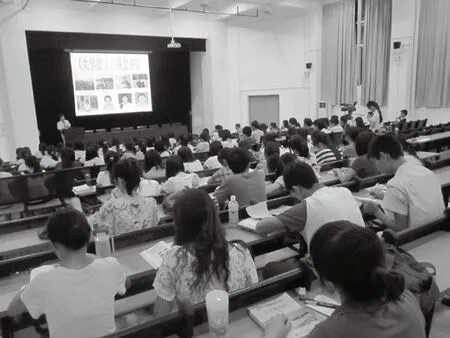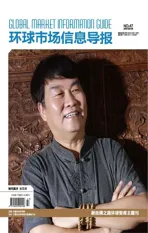How Mimetic isomorphic forces worked on HE system of China
2015-03-02方子贤
◎方子贤
How Mimetic isomorphic forces worked on HE system of China
◎方子贤
自古以来我国的高等教育就相对西方的高等教育来说有着底蕴不足,文化不够传承,缺乏创新能力的特点。因此,中国近代的高等教育发展的萌芽是在相互学习跟效仿的西方高等教育模式中演变而来的。本文以论证并分析在高等教育中同构同质作用下,我国高等教育的发展的摸索的全过程过程以及在未来同构的影响下,我国高等教育的方向将路在何方展开论述。

In this paper I would like to specify and give examples of the force of Mimetic isomorphism at work in the higher education system of China in two aspects because I have a special interest in the area of Comparative Higher Education, especially the cases in Mainland and Hong Kong SAR.
1. Mimetic isomorphic forces worked on HE system of China in history
Uncertainty invites process of imitation and copying the search for apparently legitimate and successful solutions elsewhere (DiMaggio and Powell 1983). The overall social reforms in China have followed Deng Xiaoping’s model in 1978, which was described by him in a Chinese metaphor, ‘stepping gingerly from stone to stone’. (Cai, 2003).This literally means we need to go across a river by feeling different stones at the bottom of the riverbed. This model is rather tentative than pragmatic which indicates the uncertainties in the reform practices should be taken into account. Variation and uncertainties as the major character of Chinese modernization process since the late 19th century has made the borrowing advanced experiences from foreign countries a consistent learning methodology for nearly two decades. Therefore, the history of development of Chinese modern higher education illustrates a process of borrowing foreign models (Cai, 2003).
In company with the establishment of modern universities in China in the 1890s, a variety of western ideas with respect to higher education has influenced China because there was a stage of constant fighting among warlords from 1916 to 1928 after the collapse of the last Empire in 1911. And government in that period of time is weak and futile. This provided opportunities for universities to experiment with a variety of patterns. As a result, American influences became significant when new laws passed in 1922 and 1924. The American model was reflected in several aspects in the system: a broad of directors for universities; and innovative and unregulated approaches to the curriculum (Cai, 2004).
However, the American model did not meet the norm of the Higher Education system in China. On the one hand, the credit-based curriculum system could not match the requirement arising from national re-construction. On the other hand, the American model with their concern about decentralization and democracy at the local level had leaded to some negative impacts like student activism, which threatened the interest of Chinese government because regimes between these two countries are totally different. Instead of it, Chinese authorities turned their attention to a European model. At the invitation of Chinese government, a number of European advisors from Germany, France, England and Poland came to China joining a national project on higher education reform in 1932. The reform turned the higher education system in China more centralized and standardized (Hayhoe, 1999).
The restructuring of higher education after the establishment of the People’s Republic of China wasa copy of the Soviet model, and such system continued until 1980s. The post 1993 reform have also been a process of borrowing from successful foreign practices, as the current Chinese Minister of Education. Addressed in the 2009 WCHE that one experience of Chinese higher education reform is ‘learning and assimilating advanced experience of foreign countries’. It has been argued that the reforms are obviously inclined to American model which has something to do with the privatization of financing and provision, marketization and decentralization of the administration (Yang, 2007). And then, arguments came again.

2. Mimetic isomorphic forces worked on HE system of China in recent years
Some of the findings indicated that universities and colleges in the middle or lower ranks of the hierarchy tend to emulate institutions at the top, and this trend may cause disproportion of teaching and research. For instance, some universities in the middle ranks of the hierarchy are more likely to emulate research universities when evaluating their faculties. They have specific requirements on the quantity of papers, projects or books, which are very similar to research universities on the top of the hierarchy (Mao, Dan and Wong, 2012)
Nevertheless, faculties in China from top universities have spent higher proportions of time on research, while faculties from middle and lower level universities and colleges have spent relatively lower proportions of time on research which has made the mimetic isomorphic force work difficultly in HE in China.
First, because of the limitations in resources, research resources are highly centralized in China, governments tend to give resources to top universities, middle and low level universities have fewer opportunities, which will lead to fewer research projects and less time spent on research. Second, in China, a lot of research universities keep their tradition of elite education, they have relatively lower teacher-student ratio, which means faculties in research universities do not need to spend so much time on teaching as their peers in middle or low level institutions should do.
A trend of institutional isomorphism appeared in universities and colleges in the top and middle ranks of the hierarchy in China but because the management and research resource allocation system made the situation quite different on organization behaviors. Therefore, this separation leads faculties in middlelevel universities to a dilemma as on one hand, they need to face the pressure of normative and mimetic isomorphism. On the other hand, they do not have enough research resources to achieve their goals.
However, in regard to universities and colleges in the lower ranks of the hierarchy, the situation is quite different, there is no clear imitation. The research productivity is less emphasized, while teaching and cooperation with industry are more important because most of them are vocation-based education rather than knowledge-based education, so their structure and function is quite different from research universities, which preventing them from mimicking top universities. They are more marketoriented. The gap between middle to high level universities and low level universities may cause a binary system in higher education in China in future (Mao, Dan and Wang, 2012).

(作者单位:广州番禺职业技术学院外语外贸学院)
